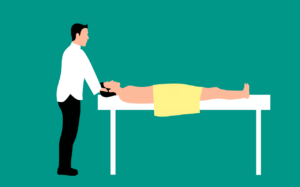
Waking up with shoulder pain from sleeping can be a frustrating experience. Whether it’s a dull ache or a sharp discomfort, it can disrupt your day and make simple tasks feel challenging. But fear not, there are simple and effective ways to relieve shoulder pain caused by sleeping. In this article, you will discover practical tips and techniques to alleviate your discomfort, so you can wake up feeling refreshed and pain-free. Say goodbye to those sleep-induced shoulder aches and embrace a restful night’s sleep once again.
Understanding the Causes of Shoulder Pain from Sleeping
Posture and Alignment Issues
When you sleep, it’s important to maintain proper posture and alignment to avoid shoulder pain. If you sleep in a position that puts strain on your shoulder joint, it can lead to discomfort and soreness. Poor posture while sleeping can include sleeping on your stomach with your arms overhead, sleeping on your side with your arm under your pillow, or sleeping on a mattress that does not provide adequate support.
Pressure Points
Pressure points can also contribute to shoulder pain when sleeping. These are areas on your body where a lot of weight is concentrated, causing discomfort and pain. If you sleep on a mattress or pillow that doesn’t properly distribute your body weight, it can create pressure points on your shoulder, leading to pain and stiffness.
Rotator Cuff Injuries
Rotator cuff injuries can also be a cause of shoulder pain from sleeping. The rotator cuff is a group of muscles and tendons that surround the shoulder joint, providing stability and allowing for a wide range of motion. If you have a pre-existing rotator cuff injury or tear, sleeping in certain positions or putting pressure on your shoulder while sleeping can exacerbate the pain and discomfort.
Frozen Shoulder Syndrome
Frozen shoulder syndrome, also known as adhesive capsulitis, is a condition where the shoulder joint becomes stiff and painful, resulting in limited mobility. Sleeping in a position that puts strain on the shoulder joint can worsen the symptoms of frozen shoulder syndrome, leading to increased pain during the night and upon awakening.
Preventing Shoulder Pain while Sleeping
Choosing an Appropriate Mattress and Pillow
Selecting the right mattress and pillow can make a significant difference in preventing shoulder pain while sleeping. Look for a mattress that provides adequate support and cushioning for your shoulders, such as a memory foam or hybrid mattress. Additionally, choose a pillow that aligns your head and neck with your spine, ensuring proper alignment and reducing strain on your shoulders.
Sleeping Positions for Shoulder Pain Relief
Experimenting with different sleeping positions can help relieve shoulder pain. Sleeping on your back with a pillow supporting your neck and a small pillow under your upper arm can promote proper alignment. If you prefer sleeping on your side, place a pillow between your knees and another pillow to support your upper arm and shoulder. Avoid sleeping on your stomach as it can strain your neck and shoulders.
Using Supportive Pillows or Cushions
If you find it challenging to maintain proper shoulder alignment while sleeping, consider using supportive pillows or cushions. Specialized shoulder pillows or cushions are designed to provide targeted support and alleviate pressure on the shoulders. These pillows or cushions can be placed under your arm or between your body and the mattress to promote proper alignment and reduce shoulder pain.
Exercises and Stretches to Relieve Shoulder Pain from Sleeping
Neck and Shoulder Rolls
Neck and shoulder rolls are simple exercises that can help relieve tension and tightness in your shoulder muscles. Begin by sitting or standing with your spine straight. Slowly roll your shoulders forward in a circular motion for 10-15 seconds and then reverse the direction. Repeat this exercise several times to loosen up your neck and shoulders.

Shoulder Blade Squeezes
Shoulder blade squeezes are effective for strengthening the muscles around your shoulder blades and improving posture. Start by sitting or standing with your arms relaxed at your sides. Squeeze your shoulder blades together as if you’re trying to hold something between them. Hold the squeeze for a few seconds and then release. Repeat this exercise 10-15 times to help alleviate shoulder pain.
Pendulum Stretch
The pendulum stretch is a gentle exercise that can help increase the range of motion and flexibility in your shoulders. Stand next to a sturdy object for support, such as a table or chair. Bend at the waist, allowing your affected arm to hang down freely. Gently swing your arm back and forth and side to side in a pendulum-like motion. Repeat this exercise for a few minutes on each side.
Corner Stretch
The corner stretch targets the muscles in your chest and shoulders to relieve tension and tightness. Stand facing a corner with your feet shoulder-width apart. Place your forearms on each side of the corner at shoulder height. Lean forward, gradually feeling a stretch in your chest and shoulders. Hold the stretch for 30 seconds and repeat a few times.
Doorway Stretch
The doorway stretch is another effective stretch for opening up your shoulders and relieving pain. Stand in a doorway with your arms bent at 90-degree angles and your forearms resting on the door frame. Lean forward slightly until you feel a gentle stretch in your chest and shoulders. Hold the stretch for 30 seconds and repeat a few times.
Child’s Pose Stretch
The child’s pose stretch is a relaxing stretch that targets your shoulders and can help alleviate pain and tension. Start by kneeling on the floor with your knees slightly wider than hip-width apart. Lower your buttocks towards your heels and extend your arms forward, resting your forehead on the floor. Hold this stretch for 30 seconds to a minute, taking deep breaths to relax your shoulders.
Cow Face Pose
The cow face pose is a yoga posture that stretches your shoulders and upper back, promoting flexibility and relieving shoulder pain. Begin by sitting on the floor with your legs crossed. Extend your right arm straight up and bend it so that your hand is reaching down between your shoulder blades. Bring your left arm behind your back and try to hold onto your right hand. Hold this pose for 30 seconds and then switch sides.
Thread the Needle
Thread the needle is a yoga pose that helps stretch the shoulders and release tension. Start on all fours in a tabletop position. Extend your right arm straight up towards the ceiling, and then thread it underneath your left arm. Lower your right shoulder and rest your right cheek on the mat. Hold the stretch for 30 seconds and then switch sides.
Applying Heat or Cold Therapy for Shoulder Pain Relief
Hot Compress
Applying a hot compress to your shoulder can help relax the muscles and relieve pain. You can use a heating pad, a hot water bottle, or a warm towel for a hot compress. Place the hot compress on your shoulder for 15-20 minutes, ensuring that it’s not too hot to avoid burns. The heat therapy promotes blood flow and helps alleviate shoulder discomfort.

Cold Compress
Using a cold compress is beneficial for reducing inflammation and numbing the area to provide pain relief. You can use a bag of frozen peas, a cold gel pack, or a cloth soaked in cold water for a cold compress. Apply the cold compress to your shoulder for 15-20 minutes, making sure to wrap it in a towel or cloth to prevent direct contact with your skin.
Alternate Heat and Cold Therapy
Alternating between heat and cold therapy can provide additional relief for shoulder pain. Start with a hot compress for 15-20 minutes, followed by a cold compress for the same duration. This contrast therapy can help reduce inflammation, increase blood flow, and relax the muscles, leading to pain relief and improved recovery.
Using Topical Analgesics or Pain-Relieving Creams
Icy Hot
Icy Hot is a popular brand of topical analgesic that can provide temporary relief from shoulder pain. It contains ingredients like menthol and camphor, which create a cooling and warming sensation to distract from pain and discomfort. Apply a thin layer of Icy Hot to your shoulder and massage it into the skin until absorbed. Repeat as needed throughout the day, following the product’s instructions.
Bengay
Bengay is another well-known pain-relieving cream that can be applied topically to the shoulder for pain relief. It contains ingredients like methyl salicylate and menthol, which help soothe sore and achy muscles. Gently massage a small amount of Bengay onto your shoulder and surrounding area. Follow the product’s instructions for the frequency of application, and avoid applying to broken or irritated skin.
Capsaicin Cream
Capsaicin cream is a natural topical analgesic that works by temporarily desensitizing nerve receptors in your skin, reducing pain signals. Apply a small amount of capsaicin cream to your shoulder and massage it into the skin until absorbed. It’s essential to wash your hands thoroughly after application to avoid accidentally getting it in your eyes or touching sensitive areas.
Over-the-Counter Pain Medications for Shoulder Pain Relief
Acetaminophen
Acetaminophen is an over-the-counter pain reliever that can be effective in managing mild to moderate shoulder pain. It works by blocking certain chemicals in the body that signal pain. Follow the recommended dosage instructions on the packaging, and consult with a healthcare professional if you have any pre-existing medical conditions or take other medications.
Nonsteroidal Anti-Inflammatory Drugs (NSAIDs)
NSAIDs, such as ibuprofen or naproxen sodium, can help reduce pain and inflammation associated with shoulder pain. These medications work by reducing the production of prostaglandins, which are inflammatory chemicals in the body. Follow the recommended dosage guidelines on the packaging, and consult with a healthcare professional if you have any concerns or contraindications.
Seeking Professional Treatment for Persistent Shoulder Pain
Physical Therapy
If your shoulder pain persists or worsens despite home remedies, it may be time to seek professional treatment. Physical therapy can help address underlying issues, improve strength and flexibility, and alleviate shoulder pain. A physical therapist will assess your condition and develop a tailored treatment plan that may include exercises, manual therapy, and modalities such as heat or cold therapy.

Massage Therapy
Massage therapy can provide relief for shoulder pain by reducing muscle tension, improving blood circulation, and promoting relaxation. A skilled massage therapist can target specific areas of your shoulder and surrounding muscles to release tightness and alleviate pain. Regular sessions may be beneficial for managing chronic shoulder pain from sleeping.
Chiropractic Care
Chiropractic care focuses on the alignment and manipulation of the musculoskeletal system. A chiropractor can assess your shoulder pain, identify any misalignments or imbalances, and perform adjustments to restore proper alignment and function. Chiropractic care may include manual adjustments, therapeutic exercises, and other modalities to alleviate shoulder pain and promote overall wellness.
Acupuncture
Acupuncture is a holistic therapy that involves inserting thin needles into specific points on the body to stimulate energy flow and promote healing. It can be an effective treatment for shoulder pain, including pain caused by sleeping. The insertion of needles triggers the release of endorphins, which are natural pain-relieving chemicals in the body. Seek a licensed acupuncturist for a personalized treatment plan.
Using Orthopedic Devices for Shoulder Support
Shoulder Brace
A shoulder brace can provide stability and support to your shoulder joint, helping alleviate pain and promoting proper alignment during sleep. These braces are typically made of breathable materials and can be easily adjusted for a comfortable fit. Wearing a shoulder brace while sleeping can help prevent excessive movement and reduce the risk of further injury or discomfort.
Posture Corrector
A posture corrector is a device that helps improve your posture by gently pulling your shoulders back and aligning your spine. Using a posture corrector during sleep can help prevent poor sleeping posture, which can contribute to shoulder pain. It promotes proper alignment and reduces strain on your shoulders and neck, allowing for a more restful sleep.
Shoulder Immobilizer
If you have a severe shoulder injury or are recovering from surgery, a shoulder immobilizer may be necessary to restrict movement and support the shoulder joint. These devices are typically worn during sleep to prevent accidental movements that could further aggravate the injury or hinder the healing process. Consult with a healthcare professional to determine if a shoulder immobilizer is appropriate for your condition.
Additional Tips to Prevent Shoulder Pain from Sleeping
Maintain a Healthy Weight
Excess weight can put additional strain on your joints, including your shoulders. Maintaining a healthy weight through regular exercise and a balanced diet can reduce the risk of developing shoulder pain from sleeping. It’s also essential to engage in activities that improve shoulder flexibility and strength, such as yoga or strength training exercises.
Avoid Sleeping on the Affected Shoulder
If you’re experiencing shoulder pain, try to avoid sleeping directly on the affected shoulder. Sleeping on your opposite side or back can help reduce pressure and minimize discomfort. If you find it challenging to avoid sleeping on the affected shoulder, using pillows or cushions for support as mentioned earlier can help alleviate the strain.
Use a Body Pillow
A body pillow can provide additional support and help maintain proper spinal alignment while sleeping. It can be especially beneficial for side sleepers by preventing the shoulder from collapsing and placing excess strain. Place the body pillow between your knees to align your hips, and hug it with your arms to provide support to your shoulders.
Practice Relaxation Techniques
Stress and tension can contribute to muscle tightness and pain, including shoulder pain. Incorporating relaxation techniques into your bedtime routine can help reduce stress and promote a more restful sleep. Deep breathing exercises, meditation, and gentle stretching can help relax your mind and body, relieving tension in your shoulders and facilitating better sleep quality.
When to See a Doctor for Shoulder Pain from Sleeping
Severe and Prolonged Pain
If your shoulder pain is severe and persists for an extended period, it’s advisable to consult with a healthcare professional. They can assess your condition, perform diagnostic tests if necessary, and recommend appropriate treatment options to address the underlying cause of your shoulder pain.
Limited Range of Motion
If you experience difficulty moving your shoulder or notice a significant reduction in your range of motion, it’s a sign that something may be wrong. Seeking medical attention can help determine the cause of limited mobility and provide appropriate interventions to improve your shoulder function.
Numbness or Tingling
Shoulder pain accompanied by numbness or tingling sensations in your arm or hand could indicate nerve involvement. It’s crucial to have a healthcare professional evaluate your symptoms to rule out any nerve impingement or other neurological conditions.
Signs of Infection
If your shoulder pain is accompanied by signs of infection, such as redness, swelling, warmth, or a fever, it’s essential to seek immediate medical attention. These symptoms could indicate a more serious underlying condition, such as an infection or abscess, that requires medical treatment.
In conclusion, shoulder pain from sleeping can be caused by various factors such as poor posture, pressure points, rotator cuff injuries, or frozen shoulder syndrome. However, there are several preventive measures and treatment options available to alleviate shoulder pain and improve sleep quality. By choosing an appropriate mattress and pillow, practicing proper sleeping positions, performing exercises and stretches, and using heat or cold therapy, you can reduce shoulder pain and promote a more restful sleep. If the pain persists or worsens, it’s important to seek professional treatment from physical therapists, chiropractors, massage therapists, or acupuncturists. Additionally, using orthopedic devices for shoulder support, maintaining a healthy weight, and practicing relaxation techniques can help prevent shoulder pain from sleeping. If your shoulder pain is severe, limits your range of motion, is accompanied by numbness or tingling, or shows signs of infection, it’s crucial to consult with a healthcare professional for proper evaluation and treatment. Remember, improving your sleep environment and taking care of your shoulder health can lead to a more comfortable and pain-free night’s sleep.







